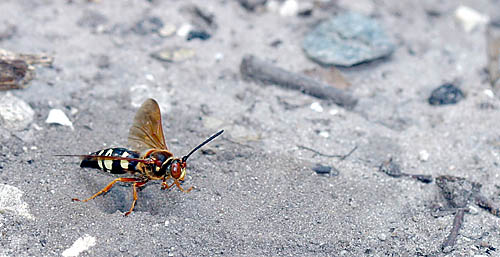Habitat
Sphecius speciosus have been found in every state
east of the Great Divide, excluding Vermont and Michigan.
Populations in the Western United States are shown to be smaller
in size
than the Eastern portion. A 2010 study by Joseph Coelho et al, showed
that Sphecius speciosus are frequently found at low
elevations and were not found in high
elevation areas such as the Appalachian and Rocky Mountain
ranges. In the study they reported one possible explanation to
avoiding high populations was due to lack cicadas to eat (Coelho et al., 2011).
Cicada killers can also be found in other
parts of the world, including portions of Mexico and Canada (Holliday
and Coehlo,
2006).
Eastern cicada killer females build underground nests by
digging holes in the dry soil with little vegetation in the
area. Vegetation makes it more difficult to dig the nest
and difficult for the female to enter and exit quickly (Coehlo
et al., 2011). Digging begins after mating and continues
throughout the summer season. While digging their mouth is used
to break up the soil, which is next pushed under their body and
propelled out of the hole by the hind legs. After the hole has
become too deep for this style to be effective, the female will
turn around and use her forelimbs to carry or push the soil with
her head. The first section of a nest is a depth of
approximately six to ten inches deep (Dambach
and Good, 1940). Once a chamber is dug, the
female will place a cicada on the floor and lay an egg on top of
it. The chamber is then sealed off with dirt and another chamber
is formed in front of it with the entrance facing the sun (Dambach
and Good, 1940). Soil type does not matter; however, tilled dry land is often
used by Sphecius speciosus because of the speed and ease for
digging. Nests are located in the close proximity to trees that
cicadas live in (Hastings et al., 2008).
Cicada killers are considered part of the subgroup of solitary
wasps (National Geographic, 2013). Wasps that make up the solitary group do not form
colonies; however some scientists are looking into different
forms of communication which may lead to females sharing
portions of their nest for smaller periods of time (Coelho, 1998).

Coehlo et al. links Sphecius speciosus' population
success to its ability to adapt to human development. The 2011
study shows reports that nearly all of the organisms found were
in some form of a humanly developed area. Most popular areas
included peoples' yards and gardens (Coehlo
et al., 2011). Another study by Coehlo, on sexual size
and flight behavior in cicada killers; shows evidence that being
one of the larger Sphecius speciosus has perks.
This study showed that larger cicada killers were less likely to
be forced out of their nests by an even larger female.
Along those same lines, larger cicada killers were able to
displace smaller Sphecius speciosus from their homes in
times of need (Coehlo, 1997).
One difference between wasp and bee homes is how they are
made. Wasps build their nests either with scavenged materials or
into existing structures such as the ground using their mouth
pieces. Bees create their hives by secreting a substance from
their bodies (National Geographic, 2013).
Cicada killers do not hibernate to other locations. If the
weather begins to get too cold for them they will enter a dormant
state until conditions become warm again (Biokids,
2013).
Home
